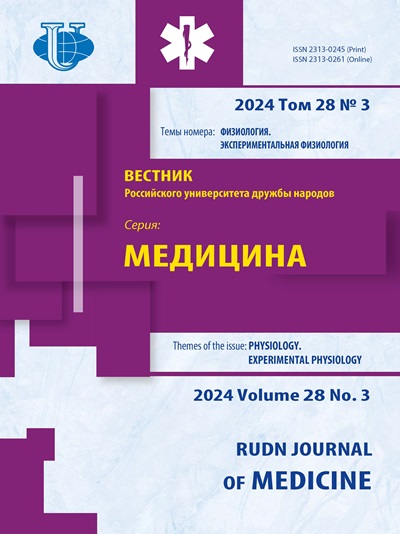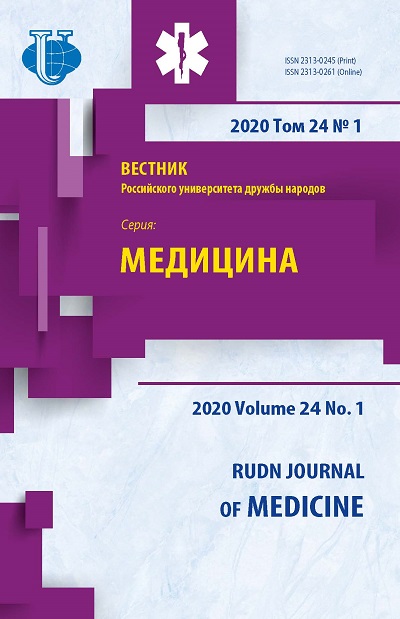Влияние транскраниальной электростимуляции на результаты трактографии фронтальной коры студентов при психоэмоциональном стрессе
- Авторы: Каде А.Х.1, Ахеджак-Нагузе С.К.2, Дуров В.В.1, Кашина Ю.В.1, Таценко Е.Г.1, Пенжоян А.Г.1, Никитин Р.В.1, Абушкевич В.Г.1
-
Учреждения:
- Кубанский государственный медицинский университет
- Научно-исследовательский институт - Краевая клиническая больница № 1 имени профессора С.В. Очаповского
- Выпуск: Том 24, № 1 (2020)
- Страницы: 75-84
- Раздел: ЭКСПЕРИМЕНТАЛЬНАЯ ФИЗИОЛОГИЯ
- URL: https://journals.rudn.ru/medicine/article/view/23397
- DOI: https://doi.org/10.22363/2313-0245-2020-24-1-75-84
Цитировать
Полный текст
Аннотация
Актуальность : транскраниальная электростимуляция обладает противострессовым эффектом у человека. Один из возможных механизмов обусловлен изменениями в функциональном состоянии фронтальной области коры головного мозга. Цель работы: оценить динамику трактографии фронтальной области коры головного мозга человека при психоэмоциональном стрессе до и после транскраниальной электростимуляции (ТЭС). Материалы и методы: Наблюдения были выполнены на 26 условно здоровых юношах. У студентов оценивали уровень стрессоустойчивости по тесту Н.Н. Киршевой, Н.В. Рябчиковой и по вариабельности ритма сердца в зачетный период. Проводили МРТ головного мозга на высокопольном томографе (напряженность магнитного поля 3 Тл) фирмы General Electric (США) с последующей программной обработкой и трактографией. 16 испытуемым (основная группа) проводили сеансы транскраниальной электростимуляции (ТЭС-терапии). ТЭС-терапию выполняли при помощи аппарата «ТРАНСАИР-02» монополярными импульсами. Сеансы проводили в вечернее время с 18 до 22 часов через день. Курс состоял из 5 сеансов по 30 минут, сила тока - от 2,0 до 3,0 мА. После курса ТЭС-терапии повторяли МРТ головного мозга и трактографию. В группе сравнения (10 человек) ТЭС-терапию не проводили, но аналогично повторяли МРТ и трактографию. По трактограммам сравнивали площадь трактов во фронтальной области коры головного мозга в обеих группах, а также до и после ТЭС-терапии. Для статистического анализа результатов исследования использовали программу «STATISTICA 10». Результаты : На трактограммах фронтальной коры головного мозга, у студентов, испытывающих стресс, обусловленный учебной нагрузкой в зачетный период, площадь трактов на трактограмме составляла 7,9±0,4 см2. После 5 сеансов транскраниальной электростимуляции уровень стрессоустойчивости повышался. На трактограммах фронтальной коры головного мозга площадь трактов увеличивалась и составляла 13,4±0,5 см2. Заключение : После транскраниальной электростимуляции при снятии психоэмоционального стресса у студентов происходит восстановление площади трактов во фронтальной области коры мозга.
Ключевые слова
Об авторах
Азамат Халидович Каде
Кубанский государственный медицинский университет
Автор, ответственный за переписку.
Email: yulia-kashina@yandex.ru
Краснодар, Российская Федерация
Саида Казбековна Ахеджак-Нагузе
Научно-исследовательский институт - Краевая клиническая больница № 1 имени профессора С.В. Очаповского
Email: yulia-kashina@yandex.ru
Краснодар, Российская Федерация
Виктор Владимирович Дуров
Кубанский государственный медицинский университет
Email: yulia-kashina@yandex.ru
Краснодар, Российская Федерация
Юлия Викторовна Кашина
Кубанский государственный медицинский университет
Email: yulia-kashina@yandex.ru
Краснодар, Российская Федерация
Елена Геннадьевна Таценко
Кубанский государственный медицинский университет
Email: yulia-kashina@yandex.ru
Краснодар, Российская Федерация
Артем Григорьевич Пенжоян
Кубанский государственный медицинский университет
Email: yulia-kashina@yandex.ru
Краснодар, Российская Федерация
Роман Викторович Никитин
Кубанский государственный медицинский университет
Email: yulia-kashina@yandex.ru
Краснодар, Российская Федерация
Валерий Гордеевич Абушкевич
Кубанский государственный медицинский университет
Email: yulia-kashina@yandex.ru
Краснодар, Российская Федерация
Список литературы
- Бердиев Р.М. Кирюшин В.А. Моталова Т.В. Мирошникова Д.И. Состояние здоровья студентов-медиков и факторы, его определяющие // Российский медико-биологический вестник имени академика И.П. Павлова 2017; 25 (2): 303-316.
- Турмасова А. А., Юдеева Т.В. Особенности адаптации студентов-первокурсников к обучению в вузе. Научно-методический электронный журнал «Концепт». 2016; (2): 461-465. URL: http://e-koncept. ru/2016/46110.htm.
- Новгородцева И.В., Мусихина С.Е., Пьянкова В.О. Учебный стресс у студентов-медиков: причины и проявления // Медицинские новости. 2015; (8): 75-77.
- Каде А.Х., Туровая А.Ю., Губарева Е.А., Вчерашнюк С.П., Ковальчук О.Д. Влияние ТЭС-терапии на динамику клинических показателей у студентов со стресс-индуцированной артериальной гипертензией // Успехи современного естествознания. 2011; 5: 131.
- Каде А.Х., Ковальчук О.Д., Туровая А.Ю., Губарева Е.А. Возможность применения транскраниальной электростимуляции для купирования стресс-индуцированной артериальной гипертензии у студентов вузов // Фундаментальные исследования. 2013; 5(1): 79-81. URL: https: //www.fundamental-research.ru/ru/ article/view?id=31463 (дата обращения: 22.01.2018).
- Каде А.Х., Ахеджак-Нагузе С.К. Изменение стрессоустойчивости у студентов при применении транскраниальной электростимуляции // Кубанский научный медицинский вестник. 2018; 2: 78-81.
- Ахеджак-Нагузе С.К. Определение динамики стрессоустойчивости по методике «Прогноз» после транскраниальной электростимуляции // Материалы международной конференции «Новые информационные технологии в медицине, биологии, фармакологии и экологии IT + M&Ec`2018» 2018; 235-238.
- Ахеджак-Нагузе С.К. Оценка стрессоустойчивости после применения транскраниальной электростимуляции // Материалы международной конференции «Новые информационные технологии в медицине, биологии, фармакологии и экологии IT + M&Ec`2018». 2018; 238-241.
- Занин С.А., Каде А.Х., Кадомцев Д.В., Пасечникова Е.А., Голубев В.Г., Плотникова В.В., Шаров М.А., Азаркин Е.В., Кочарян В.Э. ТЭС-терапия. Современное состояние проблемы // Современные проблемы науки и образования. 2017; 1: 58-69.
- Selye H.A. Syndrome Produced by Diverse Nocuous Agents. Nature. 1936; (138): 32.
- Selye H. Stress and distress / H. Selye. Compr. Ther. 1975; (1): 9-13.
- Selye H. Stress and the reduction of distress / H. Selye // The Journal of the South Carolina Medical Association. Nov., 1979. Р. 562-566.
- Селье Г. Очерки об адаптационном синдроме. М.: Иностранная литература, 1960. 254 с.
- Селье Г. На уровне целого организма. М.: Наука, 1972.
- Селье Г. Стресс без дистресса. М.: 1979, 124 с.
- Липатова А.С., Каде А.Х., Трофименко А.И. ТЭС-терапия как метод предупреждения дезадаптации у самцов крыс с высокой стрессоустойчивостью // Журнал медико-биологических исследований. 2018; 6 (4): 407-416. doi: 10.17238/issn2542-1298.2018.6.4.407.
- Blakemore S.J., Robbins T.W. Decision-making in the adolescent brain. Nat. Neurosci.2012;15:1184-1191
- Поляков П.П. Агумава А.А., СотниченкоА.С., Гусарук Л.Р., Липатова А.С., Трофименко А.И., Куевда Е.В., Губарева Е.А., Каде А.Х. Экспрессия с-fos как маркер стресс-индуцированных нейроиммуноэн-докринных нарушений и возможности ее коррекции ТЭС-терапией // Аллергология и иммунология. 2017; 18 (4): 237-238).
- Arnsten A.F.T. Stress signaling pathways that impair prefrontal cortex structure and function. Nat. Rev. Neurosci. 2009;10:410-422.
- Arnsten Amy, Carolyn M. Mazure, and Rajita Sinha Neural circuits responsible for conscious self-control are highly vulnerable to even mild stress. When they shut down, primal impulses go unchecked and mental paralysis sets in. Sci Am. 2012 Apr; 306(4): 48-53.
- Arnsten A.F.T., Goldman-Rakic P.S. Noise stress impairs prefrontal cortical cognitive function in monkeys: evidence for a hyperdopaminergic mechanism. Arch. Gen. Psychiatry. 1998;55:362-369.
- Antal A, Ambrus GG, Chaieb L. Toward unraveling readingrelated modulations of tDCS-induced neuroplasticity in the human visual cortex. Front Psychol. 2014; 5: 642. doi: 10.3389/fpsyg.2014.00642. eCollection 2014.
- Radley JJ, Sisti HM, Hao J, Rocher AB, McCall T, Hof PR, McEwen BS, Morrison JH.Chronic behavioral stress induces apical dendritic reorganization in pyramidal neurons of the medial prefrontal cortex.Neuroscience. 2004;125(1):1-6.
- Radley JJ, Rocher AB, Miller M, Janssen WG, Liston C, Hof PR, McEwen BS, Morrison JH. Repeated stress induces dendritic spine loss in the rat medial prefrontal cortex. Cereb Cortex. 2006 Mar;16(3):313-20.
- Radley JJ, Morrison JH. Repeated stress and structural plasticity in the brain. Ageing Res Rev. 2005 May;4(2):271-87.
- Stagg CJ, Lin RL, Mezue M, Segerdahl A, Kong Y, Xie J, Tracey I. Widespread modulation of cerebral perfusion induced during and after transcranial direct current stimulation applied to the left dorsolateral prefrontal cortex. J Neurosci. 2013; 33:11425-11431.
- Zheng X, Alsop DC, Schlaug G. Effects of transcranial direct current stimulation (tDCS) on human regional cerebral blood flow. Neuroimage 2011; 58:26-33.
- Шейх-Заде Ю.Р., Шейх-Заде К.Ю. Способ определения уровня стресса. Патент № 2147831 РФ, приоритет от 23.01.97. Опубл. 27.04. 2000 в БИ № 12).
- Шейх-Заде Ю.Р., Скибицкий В.В., Катханов А.М., Шейх-Заде К.Ю., Сухомлинов В.В., Кудряшов Е.А., Чередник И.Л., Жукова Е.В., Каблов Р.Н., Зузик Ю.А. Альтернативный подход к оценке вариабельности сердечного ритма // Вестник Аритмологии. 2001; (22): 49-55.
- Киршев Н.В., Рябчиков Н.В. Тест на определение стрессоустойчивости личности // Психология личности. М. 1995: 220 c.
- Михайлов В.М. Вариабельность ритма сердца (новый взгляд на старую парадигму) Нейрософт, 2017: 316 с.
- Бабунц И.В., Мириджанян Э.М., Машаех Ю.А. Азбука анализа вариабельности сердечного ритма / И.В. Бабунц, Э.М. Ставрополь, 2002: 112 с.
- Hains A.B., Vu M.A., Maciejewski P.K., van Dyck C.H., Gottron M., Arnsten A.F. Inhibition of protein kinase C signaling protects prefrontal cortex dendritic spines and cognition from the effects of chronic stress. Proc. Natl. Acad. Sci. U.S.A.2009;106:17957-17962.
- Vyas A., Mitra R., Shankaranarayana Rao B.S., Chattarji S. Chronic stress induces contrasting patterns of dendritic remodeling in hippocampal and amygdaloid neurons. J. Neurosci. 2002;22:6810-6818.
- Barsegyan A., Mackenzie S.M., Kurose B.D., McGaugh J.L., Roozendaal B. Glucocorticoids in the prefrontal cortex enhance memory consolidation and impair working memory by a common neural mechanism. Proc. Natl. Acad. Sci. U.S.A.2010;107:16655-16660.
- McKlveen J.M., Myers B., Herman J.P. The medial prefrontal cortex: coordinator of autonomic, neuroendocrine and behavioural responses to stress. Journal of neuroendocrinology. 2015. 27 (6): 446-456.
- Поляков П.П. Влияние ТЭС-терапии на характер стресс-индуцированной экспрессии c-fos нейронами паравентрикулярного ядра гипоталамуса // Уральский медицинский журнал. 2017; (5): 121-126.
- Каде А.Х., Поляков П.П., Липатова А.С., Сотниченко А.С., Куевда Е.В., Губарева Е.А. Характер экспрессии G-FOS нейронами медиальной префронтальной коры в условиях комбинированного стресса и влияния ТЭС-терапии // Современные проблемы науки и образования. 2017; (5): URL: https://www.science-education.ru/ ru/article/view?id=26877 (дата обращения: 22.01.2018).
- Липатова А.С., Поляков П.П., Каде А.Х., Трофименко А.И., Кравченко С.В. Влияние транскраниальной электростимуляции на выносливость крыс с разной устойчивостью к стрессу // Биомедицина. 2018; (1): 84-91.
- Merenlender-Wagner A., Dikshtein Y., Yadid G. The P-endorphin role in stress-related psychiatric disorders. Current Drug Targets. 2009. V. 10. P. 1096-1108.
















